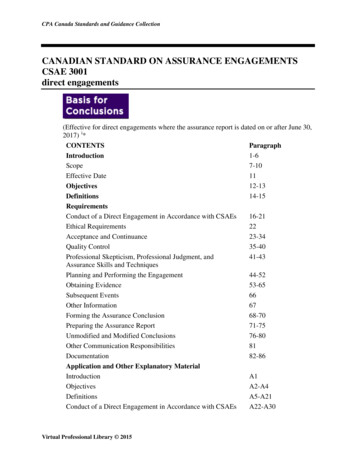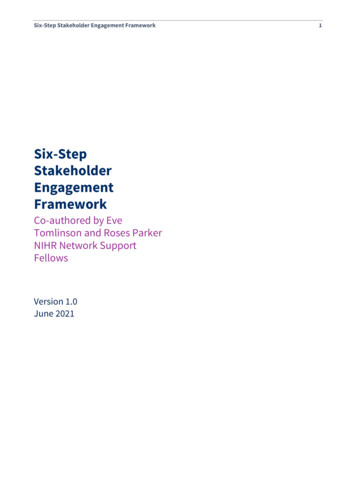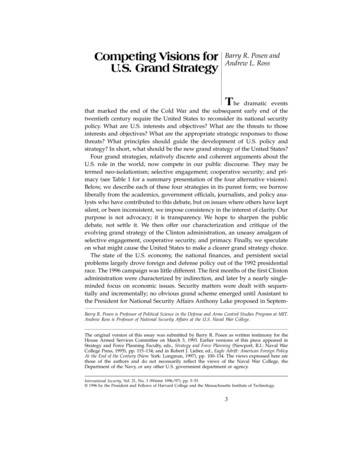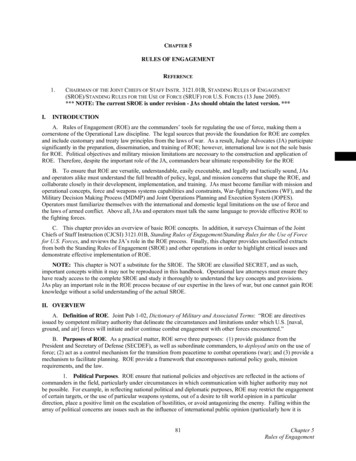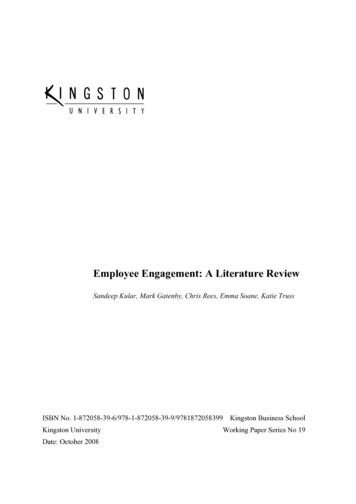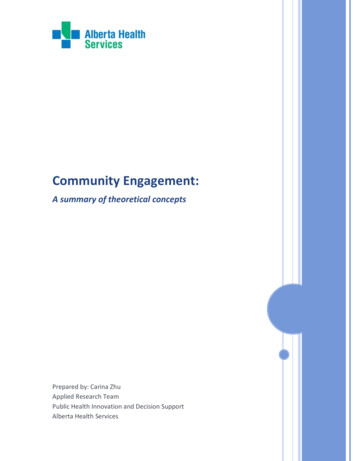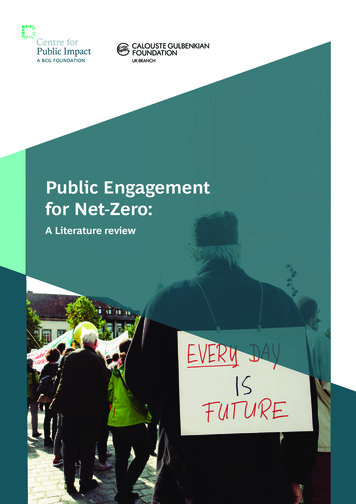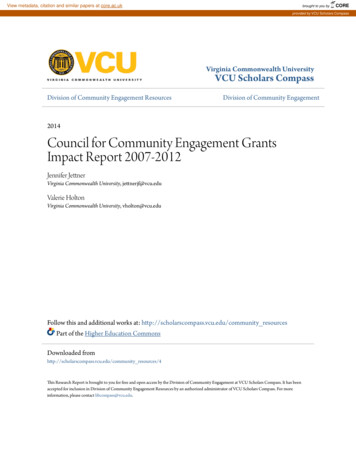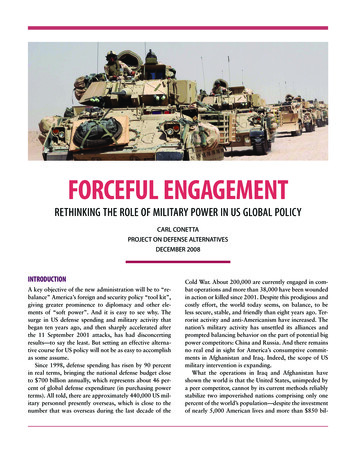
Transcription
Forceful EngagementRethinking the Role of Military Power in US Global PolicyCarl ConettaProject on Defense AlternativesDecember 2008IntroductionA key objective of the new administration will be to “rebalance” America’s foreign and security policy “tool kit”,giving greater prominence to diplomacy and other elements of “soft power”. And it is easy to see why. Thesurge in US defense spending and military activity thatbegan ten years ago, and then sharply accelerated afterthe 11 September 2001 attacks, has had disconcertingresults—to say the least. But setting an effective alternative course for US policy will not be as easy to accomplishas some assume.Since 1998, defense spending has risen by 90 percentin real terms, bringing the national defense budget closeto 700 billion annually, which represents about 46 percent of global defense expenditure (in purchasing powerterms). All told, there are approximately 440,000 US military personnel presently overseas, which is close to thenumber that was overseas during the last decade of theCold War. About 200,000 are currently engaged in combat operations and more than 38,000 have been woundedin action or killed since 2001. Despite this prodigious andcostly effort, the world today seems, on balance, to beless secure, stable, and friendly than eight years ago. Terrorist activity and anti-Americanism have increased. Thenation’s military activity has unsettled its alliances andprompted balancing behavior on the part of potential bigpower competitors: China and Russia. And there remainsno real end in sight for America’s consumptive commitments in Afghanistan and Iraq. Indeed, the scope of USmilitary intervention is expanding.What the operations in Iraq and Afghanistan haveshown the world is that the United States, unimpeded bya peer competitor, cannot by its current methods reliablystabilize two impoverished nations comprising only onepercent of the world’s population—despite the investmentof nearly 5,000 American lives and more than 850 bil-
lion. What General David Petreaus onceasked of the Iraq war—“Tell me howthis ends”—might be asked of the “waron terror” as a whole. The effort waxesand wanes, meandering into every corner of the earth, but shows no sure progress toward an end that might be called“victory.”No great wisdom is needed to suspectthat a sea-change in method is due.Giving greater play to diplomacy and“soft power” is advisable, but not sufficient. More fundamental is the need to roll back America’s over-reliance on military instruments, which hasproved both improvident and counter-productive. Thatthe United States faces serious security challenges is not atquestion. Nor at question is the need for energetic globalengagement. The problem is that the United States is usingits armed forces and military power well beyond the limitof their utility. It is now experiencing not just diminishingreturns, but negative ones. Thus, America finds itself paying more and more for less and less security.Military moderation is also essential to the revival ofAmerica’s world reputation and leadership position. This,because what most divides the United States from those itproposes to lead is the issue of when, how, and how muchto use force and the armed forces. This divide helped drivethe Bush administration deeper into unilateralism. It wasapparent during the 1990s as well, when the rise in antiAmerican sentiments first made headlines. Indeed, mostpost-Cold War US military interventions have involvedconsiderable contention with key allies. Even when theyjoin the United States on the battlefield, differences overthe use of force re-emerge at the tactical level and withregard to “rules of engagement”.Refiguring the role of force and the armed forces inUS policy will not come easily. The current balance iswell-rooted ideologically, institutionally,and politically. Some US leaders see it asreflecting America’s unique competitiveadvantage in the post-Cold War worldand as pivotal to America’s strategy forshaping the process of globalization. Butthe costly wreck that is recent policy constitutes a strong argument for a change.And the advent of a new administration inWashington provides an opportunity to go“back to the drawing board”. Unlike thefirst post-Cold War administrations, thenext one will have the benefit of hindsight—having seenclearly both the nature of today’s security challenges andthe downside of adopting an overly-militarized approachto addressing them.Mapping a path out of the current policy cul de sacbegins with the question, How did we get here?America’soveremphasis onmilitary instrumentshas proved bothimprovident andcounterproductive.Project on Defense AlternativesCommonwealth Institute186 Hampshire Street, Cambridge MA 02139617-547-4474 pda@comw.orgPDA Homepage: www.comw.org/pdaOther PDA resources, International Security Online:http://www.comw.org/infogate/The advent of primacyThe end of the East-West Cold War, beginning with thefall of the Berlin Wall in 1989, put the United States at astrategic crossroads that remains relevant today. America entered the new era with a margin of military predominance greater than that enjoyed by any power sinceRome in the Augustan age. Suggestive of the change, theUS share of world military spending rose from 28 percent in 1986 to 34 percent in 1994. (Today it stands atapproximately 46 percent, as noted above.)More relevant was the altered balance of powerbetween the United States and potential adversary states.Again, defense expenditure can serve as a proxy measure. In 1986, America’s adversaries—including Russia,China, and their allies—taken together spent 50 percentmore on defense than did the United States. By 1994, thissame group was spending 42 percent less than the UnitedStates. Although US defense spending actually declinedduring this period, aggregate spending by the adversarygroup fell faster and much further. The change affectednot only the balance in standing military forces, but alsoin command of the arms trade and in capacities for military assistance, global military presence, and militaryresearch and development.Notably, America’s margin of superiority has grownlarger since the mid-1990s, despite increased spendingby Russia and China. Today, US defense expenditures—not including war costs—are more than twice as great as2 forceful engagement: the Role of Military Power in US global Policy
Executive SummaryThe limits of forceDuring the past ten years (and especially since the 2001attacks) there has been a remarkable surge in US military spending and operations abroad. On balance, thecosts have outweighed the benefits.Despite initial successes in Afghanistan and Iraq, anover-reliance on military instruments has weakenedAmerica’s armed forces, unsettled its alliances, spurredanti-Americanism, and prompted balancing behavioron the part of China and Russia. Global terrorist activityhas increased, not decreased. And there is no real endin sight for US commitments in Iraq and Afghanistan.Instead, instability is spreading to other countries andso are US military operations.The cost-benefit balance sheet indicates that theUnited States is using its armed forces and militarypower beyond the limit of their utility. Thus, the nationfinds itself paying more and more for less and lesssecurity.The new administration seeks to place greateremphasis on diplomacy. Even more fundamental, however, is the need to roll back America’s over-relianceon military instruments. This is essential to the revivalof America’s reputation and leadership position. Whatmost divides the United States from those it hopes tolead is the issue of when, how, and how much to useforce and the armed forces.The Lure of PrimacyFor many American policy leaders, the advent of USmilitary predominance in 1992 seemed to provide theleverage with which America might enhance its security, preserve its leadership position, and advance anew vision of world order. This implied a reorientationof the military from a reactive “defense and deterrence”stance to a more proactive one. Thus, the willingnessto use force increased. So did the roles and missionsof the US armed forces. And America’s war objectivesgrew steadily more ambitious.Beyond seeking to deter and defend against aggression, there has been since 1992 an increasing emphasison using military instruments to try to actually “preventthe emergence” of threats and “shape” the strategicenvironment. In the past, these functions were largelythe job of the State Department. But the Pentagon hasbeen increasingly intruding on the provinces of State.And diplomatic functions have been increasingly militarized. Thus, “coercive diplomacy” today plays a biggerrole relative to traditional “quid pro quo” diplomacy.With the demise of the Soviet threat, Pentagonplanners refocused defense preparation on a broadarray of lesser threats and possible future ones. Theylowered the bar on the plausibility of threat scenarios and brought ”worst case” scenarios to the fore. Thisapproach was supposed to help immunize the UnitedStates against unpleasant surprises. Instead, it dissipated America’s resources and attention. Thus, whenthe 9/11 attacks came, America’s defenses were mostlypreoccupied with other concerns.Prevention and Environment ShapingThe post-Cold War focus on potential worst case scenarios also increased the attraction of taking “preventive” military action. Such action implies treatingadversaries (or potential adversaries) who do not posean imminent threat of attack as though they do. Ourrecent experience—with Iraq, Iran, and North Korea—shows that this approach can make matters worse. TheIraq case also suggests that preventive military strategies overestimate our capacity to control war outcomes and underestimate the costs and consequencesof going to war.“Environment shaping” is another form of “preventive” military activity. This encompasses America’s(continued)project on defense alternatives, december 20083
Executive Summary (continued)worldwide military presence and exercises, its alliancesand military-to-military contacts, and its arms transfersand military assistance programs. These are supposedto strongly assert or “stake out” US interests. A keygoal is to “dissuade” other nations from taking undesirable paths or competing with US power. This might bethought of as “preemptive containment” or “preemptive deterrence”.If pressed too far, efforts at armed dissuasion canbe more provocative, than helpful. If dissuasive actsimpinge on the internal affairs, sovereignty, core interests, or normal prerogatives of a target country, they arelikely to prompt resistance. Likewise, if the United Statesseems to be claiming extraordinary privileges throughdissuasive acts, others will strive to alter the power balance. In these ways, armed dissuasion can feed a process of global re-polarization and re-militarization.Precepts for a New DirectionSetting a new course in policy begins with acknowledging that the surge in US military activism that followedthe 9/11 attacks has gone too far and has become,on balance, counter-productive. National leadershipmust become more realistic about what can be reliablyaccomplished by military means and more sensitive tothe costs and chaos that attend war.Although military primacy has proved less usefulthan many had hoped, it has become a US security goalin its own right. This distorts US global policy and practice. More relevant than the power balance betweenthe United States and its adversaries is the balancebetween US power and US objectives.Military primacy is not sustainable, at any rate. Themore it is exercised, the more it invites balancing behavior on the part of others. Notably, present global disparities in military power do not reflect the distribution ofhuman and material resources. This means that othernations have considerable latent capacity to narrowthe military gap between themselves and the UnitedStates, if they so choose.Elements of an AlternativeAmerica’s armed forces should focus more narrowlyon containing, deterring, and defending against actualthreats of violence to critical national interests. Peaceand stability operations are important, but they shouldbe undertaken only as multilateral affairs under theauspices of inclusive international institutions. Effortsat “environment shaping” and “threat prevention” aremost appropriately the job of the State Department.Attempts to “hedge against uncertainty” by preparing in all directions for all scenarios will leave Americaless ready to deal with what is actually emerging. Abetter way to manage uncertainty is to invest more inintelligence and homeland protection, improve America’s capacity to quickly adapt its defenses as new circumstances arise, and ensure that the nation has thefundamental strength to absorb unexpected blowsand “bounce back”—as it did after Pearl Harbor.An alternative security policy would emphasizebroad multilateral cooperation in containing andresolving regional crises, reducing conflict potentials,and redressing the sources of instability in the international system. And, it would recognize that the sourcesof instability today are not principally military, political, or ideological in character, but instead economic,demographic, and environmental.The real measure of a renewed US diplomacy willbe efforts to reach across current strategic divides—especially to Russia, China, and the Muslim world—and find common ground. Cooperation on water, food,energy, and health security, global warming, economicdevelopment, and the management of globalizationcould serve as a foundation for progress on more divisive issues. A re-emphasis on traditional “quid pro quo”diplomacy will pay higher dividends in resolving divisive issues than will the resort to coercive diplomacyand saber rattling.4 forceful engagement: the Role of Military Power in US global Policy
those of Russia and China combined (in terms of purchasing power).The end of the Cold War also prompted strategicrealignments favoring the United States. As the Soviet blocdisintegrated, former Soviet satellites turned toward theWest and then, in 1992, the Soviet Union itself dissolvedinto 15 separate countries. Former Soviet clients in Asia,the Middle East, Africa, and the Western Hemispherefound themselves substantially shorn of material support.Equally important, the contest of ideologies and socialsystems that had helped animate the Cold War ended.Both Russia and China adopted theposture of ordinary, self-interestedgreat powers.These circumstances presenteda historic opportunity to increaseglobal cooperation, advance thedemilitarization of internationalaffairs, and claim a permanentpeace dividend. The end of the ColdWar also brought to the fore a hostof transnational problems—terrorism among them—that could beeffectively addressed only throughbroad cooperation.Grasping the promise that wasborn when the Wall came downproved from the start to be moredifficult than many had hoped. Oneproblem was that Russia, China,and other second-tier powers—including core US allies—were unwilling to simply accept American global leadership. On theAmerican side, leaders were unwilling to accept the costsand risks of building out and relying on global institutions and cooperative regimes. The “transaction costs” ofdeeper cooperation—including implied limits on America’s freedom of action—seemed too high to too many.And, of course, the United States was at odds with muchof the world over the prospective role of military power.The primacy principleMany nations, including America’s partners, have tendedto depreciate the utility of American military predominance. This, because the circumstance that produced it—the Soviet collapse—also seemed to make it less relevant.The US strategic community, by contrast, has been mes-merized by primacy. As Richard Haass, the current president of the Council on Foreign Relations, put it: “Thefundamental question that confronts American foreignpolicy is what to do with a surplus of power and the manyand considerable advantages this surplus confers.”To many, America’s new, sole-superpower statusseemed to provide the leverage with which it might further enhance its security, extend its position of worldleadership, and advance an American vision of worldorder—a “new rule set”. Implicit in these aspirations wasa reorientation of the military from a reactive “defenseand deterrence” stance to a moreproactive one.The exercise of primacy does notnecessarily entail military activism,of course. The United States also possesses abundant “soft power.” But,as “soft power” advocate JosephNye (and others) have observed:it is only in the military dimensionthat the world can be thought to beunipolar. Moreover: military poweris the policy instrument that theUnited States has in greatest supply.The US national defense budget is15 times as large as the budget forinternational affairs. And Defensecommands 200 times as many people as State.By 1997, military primacy hadbeen codified as the foundation ofUS post-Cold War security policy.The Quadrennial Defense Review and National SecurityStrategy documents of that year together asserted that USworld leadership was essential to the nation’s security andthat leadership, in turn, depended on maintaining America’s distinct global military predominance. Thus, primacybecame a security end in its own right and the cornerstone of US global policy. In 2000, Defense Secretary William Cohen publically declared the post-Cold War peacedividend to be over. (How much had America saved?Measured in 2008 dollars, the United States spent 760billion less on defense during 1991-2000 than it had during the last decade of the Cold War.)To paraphrase former UK Prime Minister MargaretThatcher: many US leaders treated US military primacy asthough it were the peace dividend. A persisting problem,however, is that military primacy does not translate auto-project on defense alternatives, december 20085
Allocation 1994Allocation 1986Average Monthly Deathsing intrusion of the Department of Defense (DOD) onmatically into strategic gains. It conveys a unique com9%the provinces of State. Parallel13%to this, diplomatic funcpetitive advantage only if national leaders can put it totions have beeneffective use. Otherwise, much of America’s post-Cold28% increasingly militarized. Thus, todayUn34%coercive diplomacy plays a bigger role relative to tradiWar military would amount to nothing more than costlyUStional “quid pro quo” diplomacy. Similarly, “offensivesurplus. Former Secretary of State Madeline Albright20%counter-proliferation”—that is, arms control by meanssuccinctly captured the problem in a 1993 conversationCoof bombardment or even regime change—has grown inabout the Balkans conflict with then-Chairman of theResimportance.Joint Chiefs, General Colin Powell. Powell had 42%said theDOD has even exerted more influence over US prooptions for effective military action in the Balkans conflict33%grams in supportand development—were limited. Albright reportedly shot back, “What’s the21% of democratizationand this influence is growing. The 2006 Quadrennialpoint of having this superb military, if we can’t use it?”Defense Review strongly advocated for greater Pentagonauthority in managingsecurity partnerships and conAllocationUS2000Allocation 2006Putting primacy to workducting development assistance programs. Already the14%Throughout the 1990s, the US national security establishPentagon 16%oversees 22 percent of US official developmentment set to work refiguring how America might effectivelyfunds—up from 3.5 percent in 1998.35%put military primacy to work. In doing so, they developed16%a set of practices and perspectives that continue to frameTheuseofforce—alastresort?18%security policy today. Surveying US policy developmentsduring the post-Cold War period:One legacy of the 20th century’s great conflicts was theemergence of a general societal presumption against war: Three successive US administrations have lowered the29% of lastthe simple31%idea that war should be an instrumentthreshold on using force, undertaking ninesignificant wars and forceful military interventions in 14 years. (By comparison, theUnited States undertook only six, small ormonthly Terrorism Fatalities Before & After 9/11modest-size combat operations during the1998-2006period 1975-1989.)500 The ways in which national leadershipimagine using force and our armed forces400have multiplied, and248.5 America’s objectives in war have grown300steadily more ambitious. These now includethe aim of fighting multiple overlapping200wars, achieving fast decisive results, over67turning regimes, and sustaining protracted100195.5109large-scale occupations.09/11 and beforeDue to 9/11 attacksAfter 9/11Terrorism in IraqOther terror attacksThe chart shows average monthly fatalities worldwide due to terrorism fortwo periods: the 44.5 months preceding (and including) 11 September 2001and the 59 months following it—that is, January 1998 through 11 August2006. These limits were set by the data available from the source, which wasfunded25000by the Department of Homeland Security.Source: MIPT Terrorism Knowledge Base (Oklahoma City, OK: National Memorial Institute forthe Prevention of Terrorism, 2006).20000Annual FatalitiesBeyond the traditional objectives of deterring and defending against aggression, therehas been an increasing emphasis on tryingto use force and forceful pressure to actually“prevent the emergence” of threats and, moregenerally, to stabilize and “shape” the strategic environment (as the 1997 US QuadrennialDefense Review put it.)In the past, threat prevention and “environment shaping” were largely in the purviewof the State Department. But a feature of ourpost-Cold War practice has been the increas-1500013349136068250100006 forceful engagement: the Role of MilitaryPower in US global Policy500029894872634270418731
Aver10067195.510909/11 and beforeDue to 9/11 attacksAfter 9/11Terrorism in IraqOther terror attacksAnnual Fatalitiesand infrequent resort, mostly restricted to defenseagainst aggression. The reasons are both moralFatalities due to terrorism worldwideand pragmatic, having to do with the inherent2004-2007unpredictability of war and its human cost. The“last resort” principle embodies an implicit rec25000ognition that war constitutes a zone of profoundand chaotic effects. Thus, it holds, we mostly20000should not go to war unless it is forced upon us.The “last resort” principle has been in retreat1360615000in US policy since the end of the East-West con13349flict. President George H.W. Bush first enunciated825010000the shift in a 1993 address at West Point. Therein,2989he set aside the common “last resort” principle500087317041for a more permissive formulation. Rather than63424872last, force might be the preferred option when02004200520062007other approaches were not thought to be as likelyto work or to work as well. It is precisely thisIraqAll othertype of complacent utilitarianism that the lastresort principle takes to be inappropriate, givenThe chart depicts fatalities caused by terrorism worldwide, divided intothe chaotic and extreme nature of war.Iraq and non-Iraq or “other” segments. The time frame was determinedA nation’s “war threshold” reflects a numberby the limits of information publically available for full years on theof considerations: For what purposes should aNational Counterterrorism Center’s Worldwide Incidents Tracking Sysnation resort to military force and threats? Whattem. The datais notto thatpreviousterIs theUScomparablemilitary presenceinpresentedthe Mideastinathestabilizingforcerorism graphor(p.6) becausethemoretwo conflictsourcesthanuse differentcriteriaandare the diplomatic prerequisites to using force?doesit provokeit prevents?*methods in tracking terrorism.How soon in a developing clash of interests68.4% Provokes morSource: National Counterterrorism Center, Worldwide Incidents Tracking System, Officeshould force be brought into play? The thresh16.6% Stabilizing forceof the Director of National Intelligence.old also pertains to the level of civilian casualties, collateral damage, and general mayhem thatEffect of Iraq war on incidence of terrorism **a nation is willing to risk.59.4% Increases attacksLowering the threshold on force can meanRefiguringthreat12.2% Decreases attacksthat the relationship between going to war and nationalself-defense becomes more attenuated. It can mean thatAt the same time that official thinking about the use ofthe limits on “pre-emptive” uses of force become loosforcewasdefenseplanners(especiallyRand***Is theUSAchanging,playing the roleof worldpolicemanmore than itatshould?er—or that forceful coercion becomes diplomacy’s routineCorporation) began exploring new ways of calibrating66.9% More than it shcompanion. It can mean that the “rules of engagement”threats and managing the security environment. These23.7% Not more than it shouldwithin war become more permissive or that firepowerideas became important enablers of increased militarycomes to play a greater role in stability operations. It canactivism.mean a greater willingness to “go it alone” in prosecutIn 1991, General Colin Powell, who was then Chairing a war or undertaking it with just a small circle ofman of the US Joint Chiefs, had observed that the Penfriends in coalition. In sum: all those considerations thattagon was “running out of demons.” But as the scale ofnormally act to limit the frequency, extent, and intensity“clear and present” dangers receded, the Pentagon refoWorldOpinionand USpreparationMilitary Powerand action on unknown andof war become less compelling.cuseddefenseCertainly, the advent of clear US military predomiprospective threats. Emphasizing “uncertainty,” plannersnance has figured in the willingness to lower the threshrelaxed their assumptions about America’s future inter6Is the US military presence in the Mideast a stabilizing forceold on using force. Additionally, the dissolution of theests and about the identity of potential foes, their capabilor does it provoke more conflict than it prevents? *16.6Soviet sphere greatly reduced the likelihood that smallities, and their objectives. Planners lowered the bar on thewars would escalate to large. Especially important is theplausibility of threat scenarios, brought ”worst case” pos59.4fact that regional conflicts no longer carry a substantialsibilities to the fore, and boosted their estimates of whatEffect of Iraq war on incidence of terrorism **risk of escalation to global nuclear war.these might require of our armedforces. Paradoxically,12.2Is the USA playing the role of world policemanmoreitprojectonthandefenseshould? ***23.7010203040667alternatives, december 200850607
as the scale and stakes of security challenges declined, thePentagon adopted more ambitious military objectives,seeking to deploy force ever faster and win wars morequickly and in more than one theater simultaneously.One aim was to be prepared to deal quickly and decisively with a very broad range of possible “surprises”.None of these were remotely as serious or immediate asthe challenge that had once been posed by the Soviet bloc.And almost none involved attacks on the US homeland.But hedging against the whole set of them worldwide substantially boosted putative defense requirements.Unfortunately,rather than immunizing the United35States against unpleasant surprises, the effort to defeat30uncertainty only dissipated America’s resources andattention.Thus, when Al Qaeda terrorists attacked the25United States in 2001, America’s intelligence agencies and20armed forces were mostly preoccupied with other concerns.15Bioterrorism, missile defense, North Korea, andChinesemilitary power dominated security discourse10in the months before 11 September. This effectively distracted5from eight years of strategic warning—beginningwith the0 1993 World Trade Center attack—and eightmonths of 1966more immediatewarningsAlQae- 20081980s19901992- regarding19962003da’s interest1971in attacking theUShomeland.Afewyears1991199520022004later, the armed forces were similarly unprepared for theDeployedcounter-insurgencyin Overseas Military Operationseventuality of protractedcampaignsStationed Overseasin Afghanistan and OtherwiseIraq.These recent failures point to a simple truth: Attemptsto hedge against uncertainty by preparing in all directionsfor all scenarios will leave a nation’s defenses less sensitiveto and prepared for what is actually emerging. In fact,the emphasis on “uncertainty” during the past decade hasallowed each military service and branch to find some justification for continuing to do and buy what it has beendoing and buying for years. Thus, despite years of talkabout “transformation”, the US military entered the newcentury looking not much different than it did in 1990,albeit smaller.It is hubris that leads policy makers and planners tothink that America can decisively trump surprise andattain complete security. A better approach to managing uncertainty is to invest more in intelligence, improveAmerica’s capacity to quickly adapt its defenses to newcircumstances as they arise, better protect those nationalassets that are most critical, and ensure that the nationhas the fundamental strength to absorb unexpected blowsand “bounce back”—as it did after Pearl Harbor.Prevention or provocation?The post-Cold War focus on potential worst case scenarios also increased the attraction of “jumping the gun”—that is, taking action early. “Acting early” can refer toseveral stratagems—preemption, prevention, or preclusion—each more risk-averse than the one preceding. Preemption involves taking action tospoil an attack that is in its preparatory stages.US Military Personnel Overseas, Active & ReservesPrevention, by contrast, involves acting force(average for periods in 000 of personnel)fully now against an adversary who officialsbelieve will attempt a serious, unavoidable700
ForceFul engagement Rethinking the Role of MilitaRy PoweR in US global Policy Carl Conetta ProjeCt on Defense alternatives DeCember 2008 IntroductIon A key objective of the new administration will be to “re-balance” America’s foreign and security policy “tool kit”, giving greater
